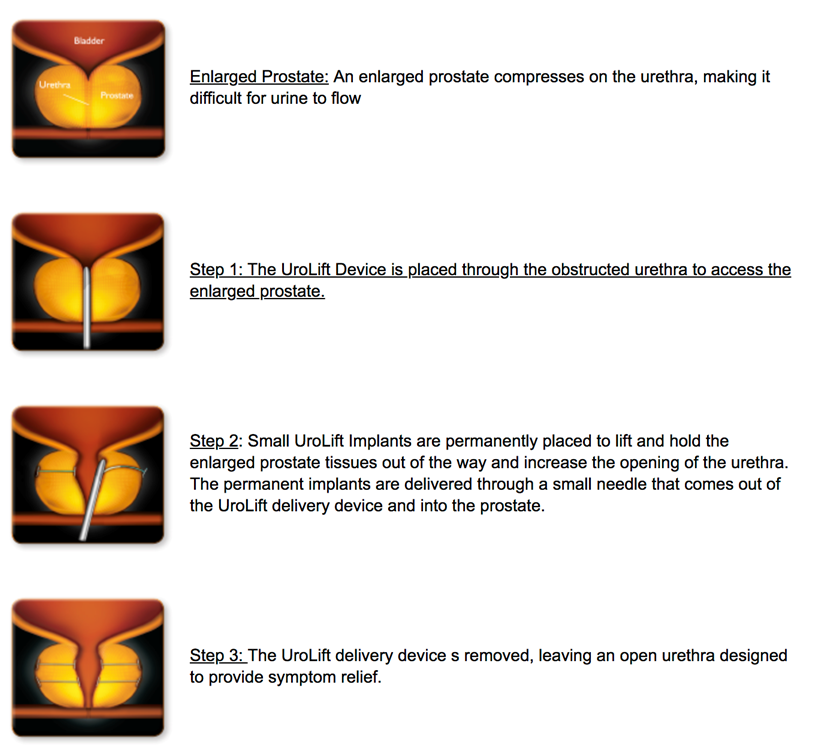

Symptoms of an enlarged prostate frequently occur in men 45 years and older:
Untreated prostate problems may lead to other medical conditions, including frequent urinary tract infections or damage to your bladder or kidneys.
How is an enlarged prostate diagnosed?
First, your doctor reviews your medical history and symptoms. Next, he performs several tests to identify an enlarged prostate, including:
For a more in-depth look at your bladder and urethra, you may require a cystoscopy procedure. Expect your doctor to insert a small tube with a lens attached into your urethra to identify an enlarged prostate and rule out other medical conditions.
What is the UroLift System?
The UroLift® System treatment is a revolutionary, minimally invasive approach to treating an enlarged prostate, or BPH, that lifts or holds the enlarged prostate tissue out of the way so it no longer blocks the urethra. There is no cutting, heating or removal of prostate tissue.
Clinical data has shown that the UroLift System treatment is safe and effective in relieving lower urinary tract symptoms due to BPH without compromising sexual function1,4. The goal of the UroLift System treatment is to relieve symptoms so you can get back to your life and resume your daily activities.
Most common side effects are light blood in the urine, some pain or discomfort when urinating, some increased urge to go and discomfort in the pelvis that typically resolve within two to four weeks after the procedure.
Advantages of the UroLift System:
How the UroLift works
The UroLift System treatment is a straightforward procedure that is performed by a urologist. The urologist places tiny implants to hold the prostate lobes apart, like open curtains on a window, to relieve compression on the urethra. This allows urine to flow normally again. The UroLift System treatment is done as an out-patient. Typically, patients return home the same day without a catheter.

The procedure uses tiny implants that keep the enlarged tissue out of the way of the urethra. Your doctor administers a local or general anesthetic before the procedure to prevent discomfort.
A UroLift device deploys those implants into the prostate tissue. The implants are permanent and provide long-term relief of enlarged prostate complications.
Your doctor performs this same-day procedure in a comfortable office environment. Following the treatment, he may prescribe medication to relieve discomfort.
After the UroLift procedure, patients typically return home the same day without a catheter. Most patients experience minimal downtime after the treatment, and many patients experience symptom relief in as early as two weeks.
During recovery, it’s not uncommon to see some blood in your urine or experience pain during urination. These issues usually resolve a week or two after the procedure. Your doctor provides instructions for proper recovery, including a timeline for when you can return to your normal routine and resume sexual activity.
East Valley Urology Center was the first practice in Arizona to have multiple doctors attain the Center of Excellence national recognition for superior outcomes with the Urolift system. Our doctors also hold national recognition for other BPH procedures as well.
Non-clinical testing has demonstrated that the UroLift Implant is MR Conditional. That means that you can be safely scanned in an MR system meeting the following conditions:
Under the scan conditions defined above, the UroLift implant is expected to produce a maximum temperature rise of 2.4°C after 15 minutes of continuous scanning.
In non-clinical testing, the image artifact caused by the device extends approximately 15 mm from the UroLift Implant when imaged with a gradient echo pulse sequence and a 3 Tesla MRI system.
Patient implant cards are provided to inform the patient that the UroLift implant is MR Conditional and can safely be scanned only under specific MR conditions.
If you have any questions about MRI safety, please consult your doctor.